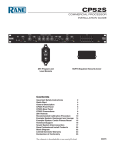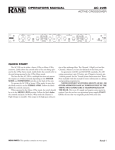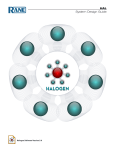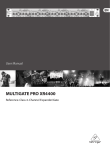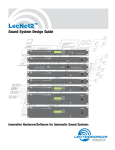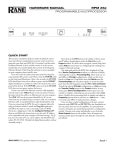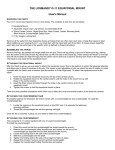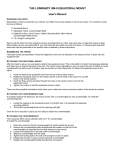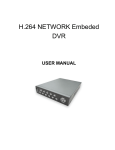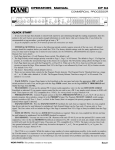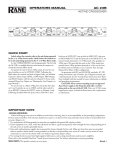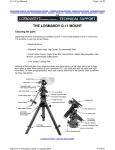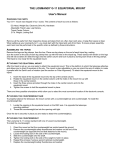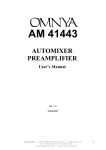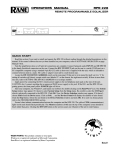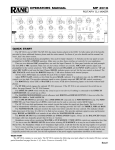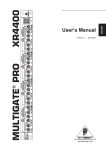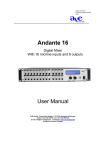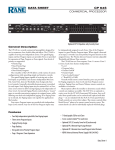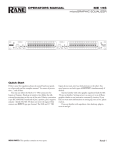Download user manual - Warehouse Sound Systems
Transcript
AUTOMIXER AM1 AM1 USB OUTPUT AUX 2 22268 LEVEL SIG LEVEL LEVEL LEVEL LEVEL SIG LEVEL LEVEL SIG OL LEVEL SIG OL LEVEL SIG Important Safety Instructions AM1 Manual AM1 & AM2 Data Sheet Sound System Interconnection Rane Professional Installation Audio Products Warranty Declaration of Conformity 1 CONTENTS (in order of appearance) MIC INPUTS 2 3 OL SIG 4 OL MIC MIX OL SIG AUX 1 OL MIX SIG AUX 2 OL SIG USB OL OUTPUT OL AUX 1 MICS SOURCE LEVEL PHONES LOCATE POWER AUTOMIXER IMPORTANT SAFETY INSTRUCTIONS 1. Read these instructions. 2. Keep these instructions. 3. Heed all warnings. 4. Follow all instructions. 5. Do not use this apparatus near water. 6. Clean only with a dry cloth. 7. Do not block any ventilation openings. Install in accordance with manufacturer’s instructions. 8. Do not install near any heat sources such as radiators, registers, stoves, or other apparatus (including amplifiers) that produce heat. 9. Do not defeat the safety purpose of the polarized or grounding-type plug. A polarized plug has two blades with one wider than the other. A grounding-type plug has two blades and a third grounding prong. The wide blade or third prong is provided for your safety. If the provided plug does not fit into your outlet, consult an electrician for replacement of the obsolete outlet. 10. Protect the power cord and plug from being walked on or pinched particularly at plugs, convenience receptacles, and the point where it exits from the apparatus. 11. Only use attachments and accessories specified by Rane. 12. Use only with the cart, stand, tripod, bracket, or table specified by the manufacturer, or sold with the apparatus. When a cart is used, use caution when moving the cart/apparatus combination to avoid injury from tip-over. 13. Unplug this apparatus during lightning storms or when unused for long periods of time. 14. Refer all servicing to qualified service personnel. Servicing is required when the apparatus has been damaged in any way, such as power supply cord or plug is damaged, liquid has been spilled or objects have fallen into the apparatus, the apparatus has been exposed to rain or moisture, does not operate normally, or has been dropped. 15. The plug on the power cord is the AC mains disconnect device and must remain readily operable. To completely disconnect this apparatus from the AC mains, disconnect the power supply cord plug from the AC receptacle. 16. This apparatus shall be connected to a mains socket outlet with a protective earthing connection. 17. When permanently connected, an all-pole mains switch with a contact separation of at least 3 mm in each pole shall be incorporated in the electrical installation of the building. 18. If rackmounting, provide adequate ventilation. Equipment may be located above or below this apparatus, but some equipment (like large power amplifiers) may cause an unacceptable amount of hum or may generate too much heat and degrade the performance of this apparatus. 19. This apparatus may be installed in an industry standard equipment rack. Use screws through all mounting holes to provide the best support. WARNING: To reduce the risk of fire or electric shock, do not expose this apparatus to rain or moisture. Apparatus shall not be exposed to dripping or splashing and no objects filled with liquids, such as vases, shall be placed on the apparatus. WARNING CAUTION RISK OF ELECTRIC SHOCK DO NOT OPEN ATTENTION: RISQUE DE CHOCS ELECTRIQUE - NE PAS OUVRIR To reduce the risk of electrical shock, do not open the unit. No user serviceable parts inside. Refer servicing to qualified service personnel. The symbols shown below are internationally accepted symbols that warn of potential hazards with electrical products. This symbol indicates that a dangerous voltage constituting a risk of electric shock is present within this unit. This symbol indicates that there are important operating and maintenance instructions in the literature accompanying this unit. WARNING: This product may contain chemicals known to the State of California to cause cancer, or birth defects or other reproductive harm. NOTE: This equipment has been tested and found to comply with the limits for a Class B digital device, pursuant to part 15 of the FCC Rules. These limits are designed to provide reasonable protection against harmful interference in a residential installation. This equipment generates, uses and can radiate radio frequency energy and, if not installed and used in accordance with the instructions, may cause harmful interference to radio communications. However, there is no guarantee that interference will not occur in a particular installation. If this equipment does cause harmful interference to radio or television reception, which can be determined by turning the equipment off and on, the user is encouraged to try to correct the interference by one or more of the following measures: • Reorient or relocate the receiving antenna. • Increase the separation between the equipment and receiver. • Connect the equipment into an outlet on a circuit different from that to which the receiver is connected. • Consult the dealer or an experienced radio/TV technician for help. CAUTION: Changes or modifications not expressly approved by Rane Corporation could void the user's authority to operate the equipment. CAN ICES-3 (B)/NMB-3(B) Shielded CAT5e or better cables are required in order to comply with the FCC Rules part 15 limits for a Class B digital device. INSTRUCTIONS DE SÉCURITÉ 1. Lisez ces instructions. 2. Gardez précieusement ces instructions. 3. Respectez les avertissements. 4. Suivez toutes les instructions. 5. Ne pas utiliser près d’une source d’eau. 6. Ne nettoyer qu’avec un chiffon doux. 7. N’obstruer aucune évacuation d’air. Effectuez l’installation en suivant les instructions du fabricant. 8. Ne pas disposer près d’une source de chaleur, c-à-d tout appareil produisant de la chaleur sans exception. 9. Ne pas modifier le cordon d’alimentation. Un cordon polarisé possède 2 lames, l’une plus large que l’autre. Un cordon avec tresse de masse possède 2 lames plus une 3è pour la terre. La lame large ou la tresse de masse assurent votre sécurité. Si le cordon fourni ne correspond pas à votre prise, contactez votre électricien. 10. Faites en sorte que le cordon ne soit pas piétiné, ni au niveau du fil, ni au niveau de ses broches, ni au niveau des connecteurs de vos appareils. 11. N’utilisez que des accessoires recommandés par Rane. 12. N’utilisez que les éléments de transport, stands, pieds ou tables spécifiés par le fabricant ou vendu avec l’appareil. Quand vous utlisez une valise de transport, prenez soin de vous déplacer avec cet équipement avec prudence afin d’éviter tout risque de blessure. 13. Débranchez cet appareil pendant un orage ou si vous ne l’utilisez pas pendant un certain temps. 14. Adressez-vous à du personnel qualifié pour tout service après vente. Celui-ci est nécessaire dans n’importe quel cas où l’appareil est abimé : si le cordon ou les fiches sont endommagés, si du liquide a été renversé ou si des objets sont tombés sur l’appareil, si celui-ci a été exposé à la pluie ou l’humidité, s’il ne fonctionne pas correctement ou est tombé. 15. La fiche du cordon d’alimentation sert à brancher le courant alternatif AC et doit absolument rester accessible. Pour déconnecter totalement l’appareil du secteur, débranchez le câble d’alimentation de la prise secteur. 16. Cet appareil doit être branché à une prise terre avec protection. 17. Quand il est branché de manière permanente, un disjoncteur tripolaire normalisé doit être incorporé dans l’installation électrique de l’immeuble. 18. En cas de montage en rack, laissez un espace suffisant pour la ventilation. Vous pouvez disposer d’autres appareils au-dessus ou en-dessous de celuici, mais certains (tels que de gros amplificateurs) peuvent provoquer un buzz ou générer trop de chaleur au risque d’endommager votre appareil et dégrader ses performances. 19. Cet appareil peut-être installé dans une baie standard ou un chassis normalisé pour un montage en rack. Visser chaque trou de chaque oreille de rack pour une meilleure fixation et sécurité. ATTENTION: afin d’éviter tout risque de feu ou de choc électrique, gardez cet appareil éloigné de toute source d’humidité et d’éclaboussures quelles qu’elles soient. L’appareil doit également être éloigné de tout objet possédant du liquide (boisson en bouteilles, vases,…). ATTENTION CAUTION RISK OF ELECTRIC SHOCK DO NOT OPEN ATTENTION: RISQUE DE CHOCS ELECTRIQUE - NE PAS OUVRIR Afin d’éviter tout risque de choc électrique, ne pas ouvrir l’appareil. Aucune pièce ne peut être changée par l’utilisateur. Contactez un SAV qualifié pour toute intervention. Les symboles ci-dessous sont reconnus internationalement comme prévenant tout risque électrique. Ce symbole indique que cette unité utilise un voltage élevé constituant un risque de choc électrique. Ce symbole indique la présence d’instructions d’utilisation et de maintenance importantes dans le document fourni. REMARQUE: Cet équipement a été testé et approuvé conforme aux limites pour un appareil numérique de classe B, conformément au chapitre 15 des règles de la FCC. Ces limites sont établis pour fournir une protection raisonnable contre tout risque d’interférences et peuvent provoquer une énergie de radiofréquence s'il n'est pas installé et utilisé conformément aux instructions, peut également provoquer des interférences aux niveaux des équipements de communication. Cependant, il n'existe aucune garantie que de telles interférences ne se produiront pas dans une installation particulière. Si cet équipement provoque des interférences en réception radio ou télévision, ceci peut être detecté en mettant l'équipement sous/hors tension, l'utilisateur est encouragé à essayer de corriger cette interférence par une ou plusieurs des mesures suivantes: • Réorienter ou déplacer l'antenne de réception. • Augmenter la distance entre l'équipement et le récepteur. • Connecter l'équipement à une sortie sur un circuit différent de celui sur lequel le récepteur est branché. • Consulter un revendeur ou un technicien radio / TV expérimenté. ATTENTION: Les changements ou modifications non expressément approuvés par Rane Corporation peuvent annuler l'autorité de l'utilisateur à manipuler cet équipement et rendre ainsi nulles toutes les conditions de garantie. CAN ICES-3 (B)/NMB-3(B) Un câble blindé de CAT5 ou de qualité équivalente voir meilleure sont nécessaires afin de se conformer à la réglementation de la FCC chapitre 15 sur les limites concernant les appareils numériques de classe B. Cartons et papier à recycler. OPERATORS MANUAL AM1 AUTOMATIC MIXER MIC INPUTS 2 3 1 MIX 4 MIC MIX AUX 1 PHONES AUX 2 USB OUTPUT SOURCE AUX 1 MICS SIG LEVEL OL SIG LEVEL OL SIG LEVEL OL SIG LEVEL OL SIG LEVEL OL SIG LEVEL OL SIG LEVEL OL SIG LEVEL OL SIG LEVEL OL AUX 2 AM1 USB OUTPUT AUTOMIXER LEVEL LOCATE POWER QUICK START If you’re setting up the AM1 automixer, but your life depends on getting back to Twitter® feeds and Facebook® posts, then this Quick Start is for you. It’s intended to get your audio working quickly in slightly more than 140 characters. Plug microphones into the Mic Inputs using standard XLR mic cables. Condenser mics need the MIC +48V switch position. Use the MIC +0V middle position for dynamic mics. Use the WIRELSS MIC position when a wireless receiver output is connected. When using the USB Charge-Only port, connect charging MP3 player audio into AUX 1 or AUX 2. Other line-level sources (e.g., DVD/CD) may also use AUX 1 or AUX 2. Use the USB Charge-Only port for keeping the iPod’s battery charged during playback. Connect the Main Output XLR to your amplifier or powered loudspeaker and select the LINE switch position. If the Main Output feeds a microphone input, select the MIC position. Connect the computer’s USB port to the USB Audio jack. Once the Windows® or Apple® operating system recognizes the AM1 as a stereo I/O device, the rear green USB light illuminates. Start with all the front panel gray knobs turned all the way down – fully counterclockwise. One at a time for each mic, talk very loudly with a microphone at an appropriate distance for the application and adjust the corresponding front panel LEVEL control so only the loudest speech just barely flickers the red overload (OL) indicators. Once the input gains are set, the AM1 automatically controls the mic mix to avoid feedback. (You won’t need to ride these controls.) Sources with output volume controls (e.g., iPods) need to be turned up most of the way to get the hottest signal, but without making the AM1 overload lights flash. WEAR PARTS: This product contains no wear parts. Play audio from your computer’s audio software application and select the Rane AM1 as the playback and/or recording device (See USB Audio later in this Manual). If the software offers playback volume, turn it up all the way. Turn on the amplifier/loudspeaker and turn it up about half way. Also turn the AM1 OUTPUT gray knob up until the volume is appropriate for your application. Use the four gray Mix knobs to adjust the relative volume of the sources. If the system feeds back (that horrible squeal), something is turned up too much. First try moving the mics farther from the loudspeaker and/or pointing the mics and loudspeakers away from each other. If this does not reduce feedback, don’t reach for the black Mic Input knobs, instead turn down the gray Mic Mix knob. While turning down the output or amplifier may help, this also turns down the iPod, CD or USB Audio, only hiding the feedback problem. If your system uses the AM1’s rear panel RAD Port, connect a shielded CAT 5e cable (or better) from the AM1 to either the wall plate RJ-45, or to a Rane HAL, EXP or Mongoose RAD port. See the Rane RADX product for useful RJ-45 wall plates. When cascading one or more AM2 automixers into the AM1, be certain each Cascade In connection feeds a Cascade Out. In a cascaded chain, the AM1 must be the last device before the analog audio connection to the amplifiers, powered loudspeaker, or the digital RAD connection to a Rane HAL, EXP or Mongoose RAD port. Only one AM1 can be included in a cascaded system of AM1s and AM2s. And only the AM2 can be cascaded into Halogen’s Gain-Sharing Auto Mixer and Room Combine Processor DSP blocks. Now you can tweet that your AM1 is working fine. Manual-1 FRONT PANEL DESCRIPTION MIC INPUTS 2 3 1 MIX 4 MIC MIX AUX 1 PHONES AUX 2 USB OUTPUT SOURCE AUX 1 MICS SIG LEVEL OL 1 SIG LEVEL OL SIG LEVEL OL SIG LEVEL OL SIG LEVEL OL 2 SIG LEVEL OL SIG 3 LEVEL OL SIG LEVEL OL SIG LEVEL AUX 2 OL AM1 USB OUTPUT AUTOMIXER LEVEL LOCATE POWER 4 5 6 7 8 90 1 MIC INPUT LEVEL controls adjust the mic input gain. The green Signal indicators inform of audio presence. Overload indicators warn of excessive signal levels. 2 MIC MIX LEVEL control adjusts the volume of all mixed microhones, including all upstream microphones when cascading additional mics from a Rane AM2 (sold separately). Signal and Overload indicators inform and warn. 3 AUX 1 & AUX 2 MIX LEVEL controls alter the mix volume of the Aux 1 and Aux 2 inputs, respectively. Corresponding Signal and Overload indicators flank each. 4 USB MIX LEVEL control adjusts the mix volume of the USB audio received from a computer connected to the rear panel USB Audio jack. Signal and Overload colors are reminiscent of holiday lights. 5 Main OUTPUT LEVEL control adjusts the level of the mix exiting the XLR output and the RAD Port output. The Record Output level is not affected by this control. 6 PHONES SOURCE cue switch selects which audio is heard in the headphone outputs: the mix of all Mics, the Aux 1 input, the Aux 2 input, the USB audio input, or the Main Output. This allows listening in headphones to any single input before turning each up in the mix using the MIX controls, or listening to the main mix before turning it up in the PA for the world to hear. 7 PHONES LEVEL control adjusts the volume of both the 3.5 mm and ¼" headphone jacks. 8 PHONES include both 3.5 mm and ¼" headphone jacks for either size headphone plug. 9 LOCATE indicator helps system installers identify a specific AM1 Automixer when using Rane’s Mongoose Tracker or Halogen software. 0 POWER indicator lights whenever adequate power is applied to the unit. Manual-2 REAR PANEL DESCRIPTION 1 MAIN OUTPUT AUDIO TX AUDIO RX USB COMM POWER POWER RECORD AUX INPUTS 2 RAD PORT 1 4 3 MIC INPUTS 2 1 MIC +48V MIC +0V WIRELESS MIC LOCATE 100-240V 50/60 Hz 13 WATTS USB AUDIO MIC +48V MIC +0V WIRELESS MIC CASCADE FAULT w MIC +48V MIC +0V WIRELESS MIC SHIELDED CAT 5e OR BETTER • 24 VDC @ 100 mA 5 VDC @ 500 mA USB CHARGE ONLY AM1 RANE CORPORATION MIC LINE PATENT NO. 8,542,849 9 q MIC +48V MIC +0V WIRELESS MIC 4 2 CLASS 2 WIRING 35 6 7 8 0 e 1 AC Power IEC input accepts electrons to power up the AM1. Though it is first in this list, it’s best to connect it last. 2 FAULT indicator lights when something goes awry. LOCATE indicator flashes when toggled from the Mongoose Tracker or Halogen software. When using multiple AM1 devices in a Rane Mongoose or HAL system, this uniquely identifies a specific AM1. USB indicator lights when a Windows or Apple operating system recognizes the AM1 as a stereo I/O sound card. POWER indicator glows when flowing electrons pass in and out of the AC Power IEC input. 3 USB AUDIO connector allows simultaneous 16-bit, 48 kHz playback and recording via a computer. The AM1 registers as a standard sound card with either Windows or Apple operating systems. 4 CASCADE IN port permits adding up to 56 more microphones to the AM1’s 4 mic inputs using up to 7 Rane AM2 automixers, sold separately. Use shielded Ethernet CAT 5e cable connected from the AM2’s Cascade Out. 5 RAD PORT connects to either a Rane HAL or Mongoose Remote Audio Device port to transport the single-channel, Main Mix of the AM1 to Rane’s expandable DSP or to a CobraNet network, respectively. 6 CASCADE IN & RAD PORT status indicators prove that proper cable termination and device configuring has occurred when all four indicators illuminate. If any of these are off or flashing, a configuration or wiring error is the culprit. 7 MAIN OUTPUT XLR connector contains the main mix of all mics, Aux 1, Aux 2 and USB Audio input signals. The front panel Output Level control adjusts the level exiting this jack. MIC/LINE Output switch changes this Main XLR Output to mic-level, for feeding the output mix to a mic input device; or line-level for feeding line-level input devices. 8 RECORD Output RCA jacks contain the same audio mix as the Main Output. The signal is not affected by the Output Level control. 9 USB CHARGE-ONLY port powers and charges many USB devices such as iPods®. 0 AUX INPUT 2 stereo 3.5 mm jack is internally monoed immediately and useful for connecting MP3 players of all kinds. q AUX INPUT 1 dual RCA jacks are internally monoed immediately and enjoy being fed audio from CD, DVD, 8-Track tape players, reel-to-reel machines, docking stations or iPhone®, iPod® or iPad® headphone jacks. w MIC INPUTS 1 thru 4 accept dynamic or condenser microphones, or the output of a wireless microphone receiver. These inputs are optimized for speech and have a fixed 80 Hz low-cut and 7 kHz high-cut filter. Both filters are 2nd-order Butterworth filters. e 3-position switches support: MIC +48V phantom power Mic position for condenser mics. MIC +0V Mic position for dynamic mics. WIRELESS MIC position intended for wireless mic receiver outputs. Manual-3 HAL Multiprocessor DIGITAL REMOTES 4 7 6 3 2 2 2 1 1 AUDIO TX RELAY OUT C NC NO C NC NO 1 + LOGIC IN COMM 8 – + G 4 3 2 1 G + 8 – 7 – + 6 – + MIC / LINE INPUTS 5 4 + 7 – + 6 – – + – LINE OUTPUTS 5 4 + – + – 3 + – + 3 + – + 2 – 2 – + + 1 – 1 – POWER EXPANSION BUS LAN LINK ETHERNET 100-240 V 50/60 Hz 55 WATTS DIGITAL REMOTES 8 LINK SHIELDED CAT5e OR BETTER 7 6 5 4 REMOTE AUDIO DEVICES & DRs 3 2 1 4 3 24 VDC @ 50 mA CLASS 2 WIRING 2 1 24 VDC @ 100 mA AM1 Automixer POWER POWER RECORD AUX INPUTS 1 4 2 RAD PORT 3 MIC INPUTS 2 1 MIC +48V MIC +0V WIRELESS MIC COMM MIC +48V MIC +0V WIRELESS MIC MAIN OUTPUT AUDIO TX AUDIO RX MIC +48V MIC +0V WIRELESS MIC USB AUDIO MIC +48V MIC +0V WIRELESS MIC CASCADE FAULT LOCATE 5 VDC @ 500 mA USB CHARGE ONLY SHIELDED CAT 5e OR BETTER • 24 VDC @ 100 mA AM1 RANE CORPORATION MIC LINE PATENT NO. 8,542,849 CLASS 2 WIRING AM2 Automixer POWER 100-240V 50/60 Hz 13 WATTS 6 5 MIC INPUTS 4 3 RAD PORT 4 3 4 3 4 3 4 3 4 3 2 1 2 1 2 1 2 1 2 1 2 1 MIC +48V MIC +0V WIRELESS MIC 7 MIC +48V MIC +0V WIRELESS MIC OUT USB DATA USB 8 OUTPUT CASCADE FAULT LOCATE MIC +48V MIC +0V WIRELESS MIC SHIELDED CAT 5e OR BETTER • 24 VDC @ 100 mA IN AM2 RANE CORPORATION MIC LINE PATENT NO. 8,542,849 CLASS 2 WIRING POWER 100-240V 50/60 Hz 13 WATTS 7 6 5 MIC INPUTS MIC +48V MIC +0V WIRELESS MIC OUT USB DATA USB 8 OUTPUT CASCADE FAULT LOCATE MIC +48V MIC +0V WIRELESS MIC SHIELDED CAT 5e OR BETTER • 24 VDC @ 100 mA IN AM2 RANE CORPORATION MIC LINE PATENT NO. 8,542,849 RAD PORT MIC +48V MIC +0V WIRELESS MIC AM2 Automixer CLASS 2 WIRING USB POWER 100-240V 50/60 Hz 13 WATTS 7 6 5 MIC INPUTS MIC +48V MIC +0V WIRELESS MIC IN OUT USB DATA 8 OUTPUT CASCADE FAULT LOCATE MIC +48V MIC +0V WIRELESS MIC SHIELDED CAT 5e OR BETTER • 24 VDC @ 100 mA MIC LINE AM2 RANE CORPORATION RAD PORT MIC +48V MIC +0V WIRELESS MIC AM2 Automixer PATENT NO. 8,542,849 CLASS 2 WIRING POWER 100-240V 50/60 Hz 13 WATTS 7 6 5 MIC INPUTS MIC +48V MIC +0V WIRELESS MIC USB DATA USB 8 OUTPUT CASCADE FAULT LOCATE MIC +48V MIC +0V WIRELESS MIC SHIELDED CAT 5e OR BETTER • 24 VDC @ 100 mA IN AM2 RANE CORPORATION MIC LINE PATENT NO. 8,542,849 RAD PORT MIC +48V MIC +0V WIRELESS MIC AM2 Automixer OUT USB AUDIO PORT Connect a USB cable from this port to the computer’s USB port. Once the operating system recognizes the AM1 as a stereo input and output “sound card,” the rear panel USB indicator lights. The AM1 can simultaneously playback and record via a computer using this USB audio port. 4 POWER 100-240V 50/60 Hz 13 WATTS MAIN OUTPUT The Main Output is a mono balanced XLR jack. Connect the Main Output XLR using mic cable to your amplifier or powered loudspeaker and select the LINE position on the adjacent switch. If the Main Output feeds a microphone snake or mic input, select the MIC switch position. 5 COMM USB RECORD OUTPUT The RCA line-level outputs are unbalanced. Both RCA jacks contain the same mono mix of the Mic, Aux, and USB Audio inputs. 3 AUDIO RX 8 RANE CORPORATION USB CHARGE-ONLY PORT The USB Charge-Only port supplies 5 volts DC at up to 500 mA to charge iPods® and many other USB-powered devices. The 3.5 mm Aux 2 input is optimized to accept audio from devices plugged in to the USB Charge-Only port. REMOTE AUDIO DEVICES HAL1X MIC +48V MIC +0V WIRELESS MIC AUX INPUTS The two Aux inputs accept line-level audio for connection to CD/DVD players and portable MP3 players utilizing the USB Charge-Only port or its external charger. While the physical ¼" and 3.5 mm jacks are both stereo, the internal audio on both Aux inputs is immediately monoed since the AM1 Mix is mono. CASCADE IN Connect a shielded Ethernet patch cable from the CASCADE IN port to a Rane AM2’s CASCADE OUT port to add more mics to the mic mix of an AM1. All four CASCADE IN Status Indicators illuminate when the two devices recognize each other. Connect up to seven Rane AM2 Automixers to add up to 56 more mics. Be certain to connect CASCADE OUT to CASCADE IN throughout – otherwise, nirvana won’t be achieved. Note: Only one AM1 Automixer is permitted in a cascaded system. When cascading mixers, the AM1 must be the device that feeds the Mongoose or HAL. In other words, the AM1 RAD Port wires to the Mongoose or HAL, and up to seven AM2 mixers chain together into the AM1’s CASCADE IN. See the illustration below. MIC +48V MIC +0V WIRELESS MIC MIC INPUTS The four mic jacks are balanced XLR inputs. Unbalanced mics or wiring can also be used with their inherent lower quality and higher potential for hum and noise. Standard microphone cable with a two-conductor twisted pair plus a shield is best. Rane follows the AES recommended practice of pin 2 positive (hot), pin 3 negative, and pin 1 to shield. If your microphone is unbalanced (only two conductors), see the Sound System Interconnection RaneNote elsewhere in this manual or on Rane’s website for the proper cable to use. Or better yet, get a balanced mic. For condenser microphones which require phantom power, use the MIC +48V switch position. Dynamic mics use the center, MIC +0V position. When connecting a wireless microphone receiver, use the WIRELESS MIC position. MIC +48V MIC +0V WIRELESS MIC Connect the AC power cord last to avoid loudspeakers hurting your sensitive ears. RAD PORT If your audio system delivers the AM1’s Main Output audio mix using Rane’s digital audio transport technology exiting the RAD Port, connect a shielded Ethernet patch cable to the RAD Port. When the Rane Mongoose or HAL at the other end of this connection recognizes the AM1’s RAD Port, audio nirvana is achieved and all four adjacent RAD Port Status indicators illuminate. MIC +48V MIC +0V WIRELESS MIC CONNECTION CLASS 2 WIRING 6 5 MIC INPUTS MIC +48V MIC +0V WIRELESS MIC USB POWER 100-240V 50/60 Hz 13 WATTS 7 MIC +48V MIC +0V WIRELESS MIC OUT USB DATA 8 OUTPUT CASCADE FAULT LOCATE MIC +48V MIC +0V WIRELESS MIC SHIELDED CAT 5e OR BETTER • 24 VDC @ 100 mA IN AM2 RANE CORPORATION MIC LINE PATENT NO. 8,542,849 RAD PORT MIC +48V MIC +0V WIRELESS MIC AM2 Automixer CLASS 2 WIRING 100-240V 50/60 Hz 13 WATTS POWER RAD PORT 7 6 5 MIC INPUTS MIC +48V MIC +0V WIRELESS MIC USB DATA MIC +48V MIC +0V WIRELESS MIC USB 8 OUTPUT CASCADE FAULT LOCATE MIC +48V MIC +0V WIRELESS MIC SHIELDED CAT 5e OR BETTER • 24 VDC @ 100 mA IN AM2 RANE CORPORATION MIC LINE PATENT NO. 8,542,849 OUT Manual-4 CLASS 2 WIRING MIC +48V MIC +0V WIRELESS MIC AM2 Automixer (up to seven) OPERATION MIC INPUTS 2 3 1 MIX 4 MIC MIX AUX 1 PHONES AUX 2 USB OUTPUT SOURCE AUX 1 MICS SIG LEVEL OL SIG LEVEL OL SIG LEVEL OL SIG LEVEL OL SIG LEVEL OL SIG LEVEL OL SIG MIC INPUTS The rear panel three-position switch sets the appropriate gain for condenser, dynamic and wireless microphones as well as selecting phantom power for condenser microphones. The Mic Inputs are automatically mixed using a gain-sharing algorithm. Set the inputs using the black knobs so they do not (or rarely) clip. Then, sit back and relax. If you’ve already set up the inputs and someone starts talking louder/closer than you expected, feel free to turn them down a little. The green Signal indicators should easily light for soft talkers even at relatively low Level settings. The Overload indicator should light only occasionally for only the loudest talkers. The gray Mic Mix knob adjusts the level of the automatic mix of all Mic Inputs. Use it to change the mix of all the Mics relative to the Aux 1, Aux 2 and USB Audio Line Inputs. Even when multiple Rane AM2 Automixers are cascaded into an AM1 providing additional microphones, the Mic Mix knob on the AM1 still adjusts the overall mix of all microphones – up to 60 mics when using seven AM2s. The Overload indicator adjacent to the Mic Mix knob indicates that the mix of all mics is getting too loud for the internal circuitry. It can light occasionally, but only during the loudest talking. Since these Mic Inputs and their underlying gain-sharing automix algorithm are designed and optimized for speech signals, do not use these Inputs with non-speech audio signals such as musical instruments or CD/DVD. AUX INPUTS The 3.5 mm Aux 2 input jack is optimized for use with devices connected to the adjacent USB Charge-Only port. For other audio sources , use the Aux 1 RCA jacks. Since the AM1 mix is mono, audio at these two stereo inputs is monoed upon entering the AM1. Adjust the front panel Aux Level controls for Aux 1 and Aux 2 to set the relative mix of these sources. The Overload indicators light when the incoming audio is getting too loud. Only the very loudest audio sources should occasionally light the Overload indicator. If you’re using an iPod® or other aux/line source that allows output volume adjustments, turn the volume up as far as possible without lighting the Overload indicator too often. LEVEL OL SIG LEVEL OL SIG LEVEL OL AUX 2 AM1 USB OUTPUT AUTOMIXER LEVEL LOCATE POWER MIXING The Mic Inputs are automatically mixed. Use the four gray Mix knobs to adjust the relative volume of the four inputs: Mic Mix, Aux 1, Aux 2 and USB Audio from the PC. The red overload indicators should light only when the loudest source sounds are running at full-tilt boogie. OUTPUTS All the AM1 audio outputs, digital and analog, contain a mono mix of the automatically mixed Mics and manually mixed Line Inputs from the four gray Mix knobs. RECORD OUTPUT The level or volume of the Record Output is not altered by the AM1’s front panel Output level control. This permits consistent recording levels on your favorite recording device, while adjusting the volume in the room / PA system. MAIN OUTPUT The front panel Output Level control adjusts the level of this output. HEADPHONE AND CUEING Plug in headphones and adjust the Phones Level knob to a comfortable volume. All headphone audio is mono – just like all the other AM1 outputs. The Source knob allows cueing each mix source independently. This allows verification that a source is working properly before bringing it into the mix. With the Source set to Output, the entire mix is heard. Use the four gray Mix knobs to adjust the relative volume of each source. Select Mic Mix to hear the automatic mix of all microphones in the system. Select Aux 1, Aux 2 or USB to hear each of these inputs individually. Use only one of the headphone jacks at a time. Manual-5 100-240V 50/60 Hz 13 WATTS AUDIO TX AUDIO RX USB COMM POWER POWER RAD PORT CASCADE IN PORT The Cascade Input allows more mics to be added to the gainsharing mic mix algorithm of the AM1’s four Mic Inputs. When a shielded Ethernet patch cable fed from an AM2 is connected here, all cascaded AM2 microphones are automatically added to the automatic Mic Mix of the AM1. (US Patent Pending.) Cascade audio is 24-bit, 48 kHz, fixed-point for the curious audio nerd. To add more microphones to your system, use a Ethernet patch cable to connect an AM2 CASCADE OUT port to the AM1 CASCADE IN port. Doing so allows all 12 mixed microphones (eight AM2 + four AM1) to be heard at the AM1’s Main, Record, USB Audio and RAD Port Outputs. When all four Cascade Status indicators light, this means the cable is wired properly. If any of the Status indicators are flashing, the cable is not wired properly or damaged. In this case, perhaps an Ethernet crossover cable was accidentally connected, or the cable crimp has an error. We recommend using shielded twisted-pair for the best EMI performance. CASCADE IN Status indicators are defined below: AUDIO TX LED – lights when the AM1’s audio is successfully transmitted to, and received by, the AM2. If this is off, check the cable. AUDIO RX LED – lights when the connected AM2 successfully sends audio which also proves this twist in the cable is correct. COMM LED – lights green when the AM2’s Cascade Out is properly communicating with the AM1 and proves that the twisted pair for Comm in the cable is good. If this indicator is off, the cable is not a happy camper. POWER LED – is always on when the AM1 is powered. If the AM1 is powered and this is off, make sure the power twisted pair in the connected cable is not shorted. Manual-6 AUX INPUTS 2 1 4 3 MIC INPUTS 2 1 MIC +48V MIC +0V WIRELESS MIC USB AUDIO RECORD MIC +48V MIC +0V WIRELESS MIC FAULT LOCATE MAIN OUTPUT MIC +48V MIC +0V WIRELESS MIC CASCADE MIC +48V MIC +0V WIRELESS MIC SHIELDED CAT 5e OR BETTER • 24 VDC @ 100 mA 5 VDC @ 500 mA USB CHARGE ONLY AM1 RANE CORPORATION MIC LINE PATENT NO. 8,542,849 CLASS 2 WIRING RAD PORT The RAD Port contains a Rane-specific digital audio transport protocol allowing audio delivery to either a Rane HAL, EXP or Mongoose RAD port (each sold separately). The audio exiting the RAD Port contains the main mix and is attenuated by the AM1’s front panel Output Level control. This port can only be used to connect to a Rane Mongoose or HAL. For inquisitive technophiles, RAD Port audio is 24-bit, 48 kHz, fixed-point. RAD PORT Status indicators are defined below: AUDIO TX LED – lights green when communications with the Mongoose or HAL has been established and is receiving the AM1’s Tx audio. If this indicator is off, either the cable is bad, or there is a communications error between the Mongoose or HAL and AM1 RAD Port (see COMM LED below). AUDIO RX LED – lights green when the RAD Port successfully receives audio from the Mongoose or HAL. If this indicator is off, you may have a bad cable, or the Mongoose or HAL at the other end of the cable is not powered or connected. COMM LED – lights green when communication is established between the Mongoose or HAL and the AM1. This indicator turns off if the RAD Port cannot communcate with the Mongoose or HAL for some reason – most likely due to a faulty cable. POWER LED – lights green when the RAD Port is receiving 24 volt power from the Mongoose or HAL. This also indicates that the twisted pair for power within the cable is wired and crimped properly. If the Power LED is off and the other end of the cable is plugged into a powered Mongoose or HAL, there is a problem with the cable. USB AUDIO I/O Since the AM1 appears as a standard Windows or Mac stereo playback and record device, you can simultaneously record the AM1 Main Mix and playback audio via the USB. This makes many popular audio software programs instantly compatible with the AM1. Once the computer’s operating system finishes registering the AM1 via USB, the rear panel USB indicator lights. The AM1 always registers as a 16-bit, 48 kHz device. Most audio programs work after setting the AM1 as a default device, but a few programs may need their preferences manually set to play or record at 16-bit, 48 kHz. Play audio from your computer’s audio software application and select the Rane AM1 as the playback and/or recording device. If your audio software offers a playback volume control, turn it up most or all of the way, but without flashing the front panel USB input Overload indicator too much. The front panel USB Mix Level knob adjusts the mix volume of the incoming USB audio. Windows Vista: Classic View Start -> Settings -> Control Panel -> Sound -> Playback (tab) and Record (tab) Control Panel Home Start -> Control Panel -> Hardware and Sound -> Sound -> Playback (tab) and Record (tab) WINDOWS OPERATION When Windows detects the AM1 it automatically sets it as the default Recording and Playback device. With Windows XP® and Vista®, any audio applications currently running will continue to use the previously selected default device. Restart the application to make it use the AM1 for recording or playback. Windows 7® and 8® automatically switch a running application to the newly connected AM1. To avoid surprises, we recommend turning the USB Level down while connecting. Remember that Windows likes to play different bleeps and bloops when updates install, devices are plugged in and unplugged, or other operating system events happen. If you do not want these sounds played into your mix, turn off Windows system sounds. This can be found in: Start -> Control Panel -> Sound -> Sounds (tab) -> Sound Scheme -> No Sounds. Finding the audio properties and devices in Windows varies slightly with each version. Windows XP: Classic View Start -> Control Panel -> Sounds and Audio Devices -> Audio (tab) Category View Start -> Control Panel -> Sounds, Speech, and Audio Devices -> Sounds and Audio Devices -> Audio (tab) Manual-7 Windows 7 and 8: Small/Large Icon View Start -> Control Panel -> Sound -> Playback (tab) and Record (tab) Category View Start -> Control Panel -> Hardware and Sound -> Sound -> Playback (tab) and Record (tab) MACINTOSH OPERATION When OSX® detects the AM1, it adds it to the list of audio input and output devices, but does not automatically set it as the default device. Some Macintosh® applications allow you to select the device you want to use. Other applications only use the device specified as the OSX default. We recommend that you set the default audio input and output device to the AM1 before starting the application you want to use. Configure the default audio device in OSX by navigating to: System Preferences -> Sound -> Output (tab) and Input (tab). Tip: to quickly access these screens, right-click on the loudspeaker icon at the lower right corner of your desktop (next to the clock). Choose “Playback Devices” or “Recording Devices.” CobraNet is a trademark of Cirrus Logic Inc. Windows XP, Vista and 7 is either a registered trademark or a trademark of Microsoft Corporation in the United States and/or other countries. Apple, Mac, Macintosh, iPod, iPad, iPhone and iTunes are trademarks of Apple Computer, Inc., registered in the US and/or other countries. ©Rane Corporation 10802 47th Ave. W., Mukilteo WA 98275-5000 TEL 425-355-6000 FAX 425-347-7757 WEB rane.com Manual-8 112067 AM1 & AM2 DATA SHEET AM1 Features AUTOMIXERS AM2 Features INPUTS: • Gain-Sharing Automatic Mic Mixing: • 4 XLR Inputs with Level controls & Sig/OL indicators. •Select Mic, Mic with 48V phantom, or Line-level. • Manually Mix: • Overall Mic Mix. • Two Aux Inputs: dual RCA & 3.5 mm, independently monoed. • USB Audio Input (16-bit, 48 kHz). INPUTS: • Gain-Sharing Automatic Mic Mixing: •8 XLR Inputs with Level controls & Sig/OL indicators. •Select Mic, Mic with 48V phantom, or Line level. OUTPUTS (all mono): • XLR Main with Mic/Line switch, Level control & Sig/OL. • Dual RCA Record. • Headphone ¼” and 3.5 mm Outputs with Level control: • Source select cues Mics, Aux 1, Aux 2, USB Input or Output. • USB Audio Output (16-bit, 48 kHz). • USB Charge Port for iPod® or other USB-powered devices. • Rane RAD and Cascade IN RJ-45 Ports: • Cascade In Port connects up to seven Rane AM2 Automixers. • RAD Port sends Output to Rane HAL or Mongoose Systems. OUTPUTS (all mono): • XLR Main with Mic/Line switch, Level control & Sig/OL. • Rane RAD and Cascade IN RJ-45 Ports: • Cascade In Port connects up to seven Rane AM2 Automixers. • RAD Port may send Output to Mongoose (CobraNet). • RAD Port may send Output to HAL (DSP/control). It is possible to cascade the AM2 mix into Halogen's Gain-Sharing Auto Mixer or Room Combine Processor DSP, so that all mics connected to HAL may gain-share (does not work with the AM1). Data Sheet - 1 AM1 & AM2 AUTOMIXERS AM1 and AM2 Common Features The Rane AM1 and AM2 may be each be used on their own as a standalone mixer, or add more gain-shared mics using up to seven AM2 Automixers. Each of the XLR Mic Inputs offers front panel input Level controls feeding a gain-sharing automatic mixer. The AM1 has four Mic Inputs, the AM2 has eight. Rear panel, 3-position switches for each Mic Input support dynamic mics (no phantom power), condenser mics (48 V), or wireless receiver outputs (+12 dBV max). A front panel Mic Mix Level control adjusts the volume of all automixed mics. The Mic Inputs are optimized for automixing speech. They have a fixed 80 Hz to 7 kHz bandpass filter (2nd-order Butterworth) to provide the best voice-only automatic mixing using a gain-sharing algorithm. Signal and Overload indicators monitor every Input Level control and the Output Mix Level. Indicators flank each corresponding Level control. The XLR Main Output can be set to Mic- or Line-level to feed a mic snake or a +20 dBu max balanced input. The front panel Output Level control affects the XLR Output and the RAD Port output. AM2 mixers may be cascaded, but only one AM1 may be used, and it must be the final unit in a chain of no more than eight AMs. Simply connect Cascade OUT ports to Cascade IN ports and the final Output level on the last AM controls the main mono output mix. Use the RAD Port to transport the main output mix digitally via shielded CAT 5e to either a Rane HAL’s RAD Port for further signal processing and control, or to a Mongoose for potential routing to a CobraNet network. Both the RAD and the Cascade IN port have status indicators to aid setup and troubleshooting. Rear panel Fault, Locate, USB and Power indicators inform head-scratchers of device errors, the AM’s physical location, positive USB audio device OS registration and AC power status. Duplicate Locate and Power indicators are on the front and rear. Universal IEC power on the rear supports 100 to 240 VAC and 50/60 Hz. Data Sheet - 2 AM1 Unique Features The Rane AM1 is part gain-sharing automatic mic mixer, part manual line mixer, part USB audio I/O device, and simultaneously a Rane RAD. Use it as a standalone mic/line mixer with up to four mics, or add more gain-shared mics using up to seven AM2 Automixers for up to 60 gain-shared mics. Three manually-mixed audio inputs provide a simple user interface and installation. The Aux 1 Input dual RCA and Aux 2 3.5 mm jacks are independently mono’ed, each with a front panel Level control. A dedicated USB Charge port adjacent to Aux 2 provides power to USB devices such as iPods® or other USB-powered devices. The separate orange USB Audio Input also offers a front panel Level control for the 16-bit, 48 kHz digital audio that is mono’ed immediately upon entry. The AM1 appears in Windows and Apple OS X computers as a standard USB Audio Device, immediately compatible with dozens of audio recording and playback audio applications. The AM1 registers with the OS as a 16-bit 48 kHz device for both incoming and outgoing audio. The USB Audio port doubles as a firmware update port if future updates become available. The front panel Output Level control affects the XLR Output and the RAD Port output. The analog RECORD RCA Outputs and the digital USB Audio output are both mono, pre-Output Level, containing the same mix as the Main Output. A front panel pre-Output Selector permits headphone cueing so users can verify input and output operation before bringing new sources into the live Output mix. Both ¼" & 3.5 mm headphone jacks with a Level control are provided. AM2 Unique Features The Rane AM2 is both an 8 channel, gain-sharing automatic mic mixer and simultaneously a Rane RAD. Use it as a standalone mic-only mixer, or add more gain-shared mics using up to seven additional AM2 Automixers for up to 64 gain-shared mics. When an AM2 is used standalone, both the XLR Output and the RAD Port output audio are affected by the front panel Output Level control. When the AM2’s Cascade Output feeds a downstream Rane AM1 or AM2, the front panel Output Level control only affects the XLR Output. The USB port is solely used as a firmware update port if future updates are needed. AM1 & AM2 AUTOMIXERS Cascaded AM System Example Record to or playback from your computer on USB. DVD MP3/ Phone Powered Speaker MENU Wireless Receiver AM1 Automixer COMM POWER POWER 4 2 RAD PORT 3 MIC INPUTS 2 1 MIC +48V MIC +0V WIRELESS MIC AUDIO RX 1 MIC +48V MIC +0V WIRELESS MIC AUDIO TX USB AUX INPUTS MIC +48V MIC +0V WIRELESS MIC LOCATE USB AUDIO RECORD 5 VDC @ 500 mA USB CHARGE ONLY FAULT 100-240V 50/60 Hz 13 WATTS MAIN OUTPUT CASCADE MIC +48V MIC +0V WIRELESS MIC SHIELDED CAT 5e OR BETTER • 24 VDC @ 100 mA AM1 RANE CORPORATION MIC LINE PATENT NO. 8,542,849 CLASS 2 WIRING To HAL (optional) AM2 Automixer 5 MIC INPUTS 4 3 RAD PORT 4 3 2 1 2 1 MIC +48V MIC +0V WIRELESS MIC 6 MIC +48V MIC +0V WIRELESS MIC USB POWER 100-240V 50/60 Hz 13 WATTS 7 MIC +48V MIC +0V WIRELESS MIC LOCATE USB DATA OUT FAULT 8 OUTPUT CASCADE MIC +48V MIC +0V WIRELESS MIC SHIELDED CAT 5e OR BETTER • 24 VDC @ 100 mA IN AM2 RANE CORPORATION MIC LINE PATENT NO. 8,542,849 CLASS 2 WIRING Any combination of wired or wireless mics 6 5 MIC INPUTS 4 3 2 1 MIC +48V MIC +0V WIRELESS MIC 7 MIC +48V MIC +0V WIRELESS MIC IN RAD PORT MIC +48V MIC +0V WIRELESS MIC USB POWER MIC LINE LOCATE 100-240V 50/60 Hz 13 WATTS USB DATA 8 OUTPUT CASCADE FAULT USB cable Ethernet (CAT 5e) Audio cable All additional mics will gain-share OUT AM2 MIC INPUTS CLASS 2 WIRING SHIELDED CAT 5e OR BETTER • 24 VDC @ 100 mA RANE CORPORATION 5 MIC +48V MIC +0V WIRELESS MIC RAD PORT Additional AM2s (up to seven) PATENT NO. 8,542,849 6 MIC +48V MIC +0V WIRELESS MIC USB POWER 100-240V 50/60 Hz 13 WATTS 7 MIC +48V MIC +0V WIRELESS MIC LOCATE USB DATA OUT FAULT 8 OUTPUT CASCADE MIC +48V MIC +0V WIRELESS MIC SHIELDED CAT 5e OR BETTER • 24 VDC @ 100 mA IN AM2 RANE CORPORATION MIC LINE PATENT NO. 8,542,849 MIC +48V MIC +0V WIRELESS MIC AM2 Automixer CLASS 2 WIRING Data Sheet - 3 AM1 & AM2 AUTOMIXERS AM1 and AM2 as RADs with Mongoose or HAL RADs An entire family of RAD models interface with HAL or Mongoose Systems for digital conversion at the wall. Each converts analog audio to and/or from 24-bit, 48 kHz digital audio. Shielded CAT 5e (or better) cable and termination transport four digital audio channels – two channels each direction – as well as power, ground and a communications channel, with status indicators at each RAD, host unit, and host software. All RADs are both “location-aware” and hot-swappable with 500-foot homerun connections (66% farther than Ethernet). Most RADs mount in standard US electrical boxes, and are available in white, ivory, or black, with a matched Decora™ plate cover included. Mongoose Mongoose can replace the analog mic and line level portions of an audio system with digitized audio over shielded CAT 5e cable (or better). Mongoose can be used with or without CobraNet. The Mongoose’s 32-by-32 digital audio matrix router receives its first 16 audio channels from up to eight RADs via the eight rear panel 8P8C (RJ-45) Remote Audio Device ports. The second 16 matrix input channels come from two eight-channel CobraNet receive (Rx) Bundles via standard CobraNet Primary and Secondary/backup ports. The 32 matrix router outputs transmit 16 channels to eight RADs and 16 more channels to two CobraNet transmit (Tx) Bundles. Mic inputs can be greatly increased by connecting a RAD output from an AM1 and/or cascaded AM2s. Find out more at rane.com/mongoose HAL1 Meet HAL, an expert in room combining, paging and distributed audio systems. This groundbreaking architecture is dimensions beyond any other solution. HAL easily guides even novice users through what used to be complex tasks in just minutes. No intricate matrix mixing or presets are required for room combining and paging. No virtual wiring required to distribute pages and background music to multiple zones. Data Sheet - 4 Seamlessly interface HAL to your facility with a broad variety of peripheral devices including smart Digital Remotes, RADs, portable and in-rack automixers, audio I/O and control logic expansion devices, wall sensors, ambient sensing mics, small remote amplifiers, and an advanced Paging Station. The HAL and Halogen software check the status, location, CAT 5 wiring integrity, and that audio is flowing in all peripheral devices, so you know your system is properly connected and ready to go. HAL is more than just another DSP drag-and-drop system — it has revolutionized system design and installation. Three HAL Multiprocessors provide various audio I/O and control options for both large and small installations, with expandable systems capable of hundreds of mics (HAL1) or economical and adaptable 4 in x 8 out (HAL3). Find out more at rane.com/hal AM Automixers with HAL An AM1 is a RAD, and an AM2 is a RAD, and the final output of cascaded AM mixers is a RAD. Any of these allow the manually created mono mix to be sent digitally to a Rane HAL’s RAD port via a shielded CAT 5e cable (or better). The Rane RADX supports doing so portably – with the AM mixer(s) in a padded rack or on a portable AV cart, for example. Once the AM mix is in the HAL, additional signal processing such as EQ and compression can be added. Control of the mix’s level using Rane’s DR1 or DR3 Digital Remotes is a breeze. AM1 use with HAL The AM1 does not have a Cascade Out Port, therefore it is not possible to cascade the AM1 mix into Halogen’s Gain-Sharing Auto Mixer or Room Combine Processor. You must use the AM2 mixer for cascading with these DSP blocks. AM2 use with HAL The AM2 mixer digitally cascades into Halogen’s Gain-Sharing Auto Mixer or Room Combine Processor. This means the gainsharing algorithm automatically treats AM2 microphones and any other microphone wired into these DSP blocks as being part of the same gain-share. This provides superior gain before feedback since all mics in the room, regardless of where and how they are plugged in to the audio system, all work as one. This maintains your feedback stability margin. To maintain PAG & NAG like you never have before, connect the AM2’s Cascade Out jack with a shielded CAT 5e (or better) cable into any HAL’s RAD port. In Halogen software, in the Processing Workspace, drag the AM2 onto the Cascade In on either a Gain-Sharing Auto Mixer or a Room Combine Processor. You can cascade as many AM2 mixers into these two DSP blocks as you have RAD Ports available. With a maximum of 36 total RAD ports in a HAL1 full with EXP1s, and a maximum of 8 AM2s cascaded externally, over two thousand possible channels are possible! AM1 & AM2 AUTOMIXERS Features and Specifications XLR Inputs Phantom Power Maximum Input Input Impedance Input Gain Range (Mic/Wireless) Frequency Response AM1 Aux Inputs 1 / 2 Maximum Input Input Impedance Gain Range Frequency Response Main Output Maximum Output (Mic/Line) Output Impedance (Mic/Line) Output Gain Range Dynamic Range (Line) AM1 Frequency Response AM2 Frequency Response AM1 THD+N AM2 THD+N AM1 Record Output Maximum Output Output Impedance Frequency Response Dynamic Range THD+N AM1 Headphone Output Maximum Output Maximum Output Power Output Gain Range Frequency Response Dynamic Range THD+N LED Meters Signal Overload RAD / Cascade In / Out Sample Rate and Resolution AM1 USB Digital Audio Sample Rate and Resolution AM1 USB Charge Only Port Output Voltage and Current Unit Universal Line Voltage Conformity U.S. Patent No. 8,542,849 Size Weight Shipping Size Shipping Weight Mono, Balanced, Mic/Line Selectable +48V per IEC 60268-15, Selectable in Mic mode -18 dBV / -6 dBV / +12 dBV (Dynamic / Condenser / Wireless) 2.01k, 1% -80 to +34 dB / -80 to +26 dB 80 Hz to 7 kHz, 2nd-order Butterworth, +0/-3 dB, -20 dBFS, Extended vocal range Dual Mono, Unbalanced, RCA / 3.5 mm TRS +8 dBu 18.8 kΩ, 1% -80 to +12 dB 20 Hz to 20 kHz, +0/-0.25 dB Mono, Balanced, XLR -20 / +20 dBu, 10 kΩ load 51 / 300 Ω, 1% -80 to 0 dB 101 dB re +20 dBu, 20 kHz BW, A-weighted, 0 dB gain, 10 kΩ load 23 Hz to 20.5 kHz, +0/-3 dB 80 Hz to 7 kHz, +0/-3 dB, -20 dBFS < 0.01%, 22 Hz to 20 kHz, A-weighted, +4 dBu, 0 dB gain, 10 kΩ load < 0.02%, 100 Hz to 7 kHz, A-weighted, +4 dBu, 0 dB gain, 10 kΩ load Dual Mono, Unbalanced, RCA +12 dBu, 10 kΩ load 602 Ω, 1% 23 Hz to 20.5 kHz, +0/-3 dB 101 dB re +12 dBu, 20 kHz BW, A-weighted, 0 dB gain, 10 kΩ load < 0.01%, 22 Hz to 20 kHz, A-weighted, +4 dBu, 0 dB gain, 10 kΩ load Dual Mono, Unbalanced, ¼" and 3.5mm TRS +9 dBu, 150 Ω load 30 mW into 150 Ω -63 to +16 dB 23 Hz to 20.5 kHz, +0/-3 dB 101 dB re +9 dBu, 20Hz to 20 kHz BW, A-weighted, 0 dB Gain, 150 Ω load < 0.06%, 22 Hz to 20 kHz, A-weighted, +4 dBu, 0 dB gain, 150 Ω load Mono, peak detecting -50 dBFS, Green LED, Peak-Reading -0.5 dBFS, Red LED, Peak-Reading 8P8C (RJ-45) Connector. The AM2 has a Cascade Output, the AM1 does not. 48 kHz @ 24 bits, fixed-point Dual Mono In/Out, USB-B connector 48 kHz @ 16 bits USB-A Connector +5 V max @ +500 mA max All Steel Construction 100 to 240 VAC, 50/60 Hz, 13 W CE, FCC, CCSAUS 1U 1.75"H x 19"W x 8.5"D (4.4 cm x 48.3 cm x 21.6 cm) 5 lb 4 oz (2.4 kg) 4.5" x 20.3" x 13.75" (11.5 cm x 52 cm x 35 cm) 9 lb (4.1 kg) Note: 0 dBu = 0.775 Vrms Data Sheet - 5 AM1 & AM2 AUTOMIXERS Applications Facilities and rental agencies are called upon to provide either equipment, or equipment and operators, for meetings or conferences needing A/V support. The equipment providers must ensure audio quality throughout the event to get repeat business. However, the provided equipment may be operated by presenters who have no audio experience. If an operator is sent with the equipment to set up and manage the system during the presentation, that operator may have little audio experience. Pitfalls abound when interconnecting the system, and managing multimicrophone gain before feedback, mixing and volume. Handling iPod and laptop playback and/or recording adds even more complexity. Enter the Rane AM Automixer. The AM1 makes it easy for an inexperienced operator to quickly set up and manage audio for a multimedia presentation involving up to four participants with microphones (wired or wireless) and several program audio sources (e.g., DVD, Laptop, MP3 player). The AM2 easily handles an eight-person discussion panel or board meeting. Additional AM2 mixers easily handle more mics when needed, all gain-sharing, making operation simple. The AM1 provides line audio sources, manually mixed since there is no acoustic feedback potential. The AM1’s flexible line input combination of RCA, 3.5 mm and separate USB Charge and Audio I/O ports makes integration and cabling easy. And since the USB Audio port can simultaneously playback audio and record the AM1’s output, the same laptop can be a source and a recording device to document AV meetings, presentations, trainings, and family karaoke nights for AV contractor employees. The AM Automixer offers a professional integrated solution that provides superior automatic gain before feedback while eliminating operator error with simple controls. The microphone gain-sharing algorithm automatically and appropriately attenuates mics not in use while maintaining the 3 dB per doubling of mics for different (noncoherent) talkers, and 6 dB per doubling for the same (coherent) talker who is directly between two mics. Think of the person wearing a live lavalier or headset, while approaching a live podium mic...no problem! Data Sheet - 6 • • • • AV Rental Systems Auditoriums Conference Centers Houses of Worship • • • • Hotels School AV Nerds Panel Discussions Podcasting AM1 Architectural Specifications The 1U audio device shall provide 4 rear-mounted XLR inputs automatically mixed using a gain-sharing algorithm. Each input shall permit independently selectable mic, mic with 48 volt phantom power, or line input level intended for wireless receiver output. Front panel mic input level controls for each input shall indicate signal and overload and an overall mic mix level control with signal and overload shall be provided. Three manually-mixed inputs shall include dual RCA inputs, a 3.5 mm stereo jack and dedicated USB charge port, and an independent USB audio input; all three shall be monoed before mixing. Front panel mix level controls for all three inputs shall supply signal and overload indication. Accommodation for two, post-level audio outputs shall be provided. One on a single XLR male balanced analog output with mic/line selector switch and the second via a Rane RAD Port on RJ-45 providing 24-bit, 48 kHz PCM digital audio transport. A mono, pre-output level mix shall be provided on dual-mono RCA jacks and via a USB Audio port providing 16-bit, 48 kHz PCM audio. The USB Audio I/O port shall be recognized by Windows and Apple OS X devices as a standard USB audio device permitting simultaneous playback and recording to and from the device. A cascade input RJ-45 shall permit gain-sharing mic mix expansion in groups of 8 channels from external automixer devices. Up to 60 gain-shared mics shall be supported. A front panel pre-level selector shall provide headphone cueing with level control of either the mic mix, the RCA input, 3.5 mm input, the USB audio input, or the main output mix. Headphone outputs shall be provided on both ¼" and 3.5 mm jacks. Universal 100 to 240 volt AC, 50 or 60 Hz operation shall be provided via an IEC rear panel plug. The unit shall be a Rane AM1. AM1 & AM2 AUTOMIXERS +48V PHANTOM / MIC / WIRELESS INPUT 1 2 3 1 AM1 Block Diagram SIG/OL LEVEL +48V PHANTOM / MIC / WIRELESS INPUT 2 2 3 1 MICS AUX 1 SIG/OL AUX 2 USB LEVEL PHONES SOURCE PHONES 4.5 dB LEVEL TIP RING OUTPUT +48V PHANTOM / MIC / WIRELESS INPUT 3 2 3 1 SIG/OL 1/4” HEADPHONES AUTO GAINSHARING MIX 4.5 dB TIP RING 3.5mm LEVEL +48V PHANTOM / MIC / WIRELESS INPUT 4 2 3 1 SIG/OL SIG/OL LEVEL MIC/LINE CASCADE INPUT MIC MIX LEVEL STATUS MAIN OUTPUT OUTPUT LEVEL 2 1 3 RAD PORT CHANNEL 1 OUTPUT AUX 1 INPUT MONO SIG/OL LEVEL MANUAL MIX SIG/OL STATUS AUX 2 INPUT 3.5mm TIP RING USB INPUT MONO RCA RECORD OUTPUT SIG/OL LEVEL SIG/OL LEVEL USB INPUT (MONO, 48 kHz, 16-BIT) USB OUTPUT USB OUTPUT (MONO, 48 kHz, 16-BIT) Data Sheet - 7 AM1 & AM2 AUTOMIXERS +48V PHANTOM / MIC / WIRELESS INPUT 1 2 3 1 AM2 Block Diagram SIG/OL AUTO GAINSHARING MIX LEVEL +48V PHANTOM / MIC / WIRELESS INPUT 2 2 3 1 OUTPUT OUTPUT LEVEL 2 1 3 SIG/OL LEVEL +48V PHANTOM / MIC / WIRELESS INPUT 3 2 3 1 MIC/LINE SIG/OL RAD PORT / CASCADE OUTPUT MIX OUT CASCADE OUT SIG/OL STATUS LEVEL +48V PHANTOM / MIC / WIRELESS INPUT 4 2 3 1 SIG/OL LEVEL +48V PHANTOM / MIC / WIRELESS INPUT 5 2 3 1 SIG/OL LEVEL +48V PHANTOM / MIC / WIRELESS INPUT 6 2 3 1 SIG/OL LEVEL +48V PHANTOM / MIC / WIRELESS INPUT 7 2 3 1 SIG/OL LEVEL +48V PHANTOM / MIC / WIRELESS INPUT 8 2 3 1 AM2 Architectural Specifications The 1U audio device shall provide 8 rear-mounted XLR inputs automatically mixed using a gain-sharing algorithm. Each input shall permit selectable mic, mic with 48 volt phantom power, or line input level intended for wireless receiver outputs. Front panel mic input level controls for each input shall indicate signal and overload and an overall output level control with signal and overload shall be provided. When used standalone without cascading addition mics, accommodation for two, post-level audio outputs shall be provided. One on a single XLR male balanced analog output with mic/line selector switch and the second via a Rane RAD Port on RJ-45 providing 24-bit, 48 kHz PCM digital audio transport to a Rane Mongoose or HAL. When cascading additional gain-shared mics downstream, the front panel output level control only affects the XLR Output. A USB data port shall be provided to support firmware updates should they be needed. A cascade input RJ-45 shall permit gain-sharing mic mix expansion in groups of 8 channels from external automixer devices. Up to 64 gain-shared mics with a maximum of eight 1U devices shall be supported. To input line audio sources or perform headphone cueing, a Rane AM1 is supported. Universal 100 to 240 volt AC, 50 or 60 Hz operation shall be provided on an IEC rear panel plug. The unit shall be a Rane AM2. SIG/OL LEVEL CASCADE INPUT Data Sheet - 8 STATUS ©Rane Corporation 10802 47th Ave. W., Mukilteo WA 98275-5000 TEL 425-355-6000 FAX 425-347-7757 WEB rane.com Specifications subject to change without notice. 9-2015 RaneNote SOUND SYSTEM INTERCONNECTION Sound System Interconnection • Cause & prevention of ground loops • Interfacing balanced & unbalanced • Proper pin connections and wiring • Chassis ground vs. signal ground • Ground lift switches Rane Technical Staff Introduction This note, originally written in 1985, continues to be one of our most useful references. It’s popularity stems from the continual and perpetual difficulty of hooking up audio equipment without suffering through all sorts of bizarre noises, hums, buzzes, whistles, etc.— not to mention the extreme financial, physical and psychological price. As technology progresses it is inevitable that electronic equipment and its wiring should be subject to constant improvement. Many things have improved in the audio industry since 1985, but unfortunately wiring isn’t one of them. However, finally the Audio Engineering Society (AES) has issued a standards document for interconnection of pro audio equipment. It is AES48, titled “AES48-2005: AES standard on interconnections —Grounding and EMC practices — Shields of connectors in audio equipment containing active circuitry.” Rane’s policy is to accommodate rather than dictate. However, this document contains suggestions for external wiring changes that should ideally only be implemented by trained technical personnel. Safety regulations require that all original grounding means provided from the factory be left intact for safe operation. No guarantee of responsibility for incidental or consequential damages can be provided. (In other words, don’t modify cables, or try your own version of grounding unless you really understand exactly what type of output and input you have to connect.) RaneNote 110 © 1985, 1995, 2006, 2007, 2011 Rane Corporation Interconnection-1 Ground Loops Almost all cases of noise can be traced directly to ground loops, grounding or lack thereof. It is important to understand the mechanism that causes grounding noise in order to effectively eliminate it. Each component of a sound system produces its own ground internally. This ground is usually called the audio signal ground. Connecting devices together with the interconnecting cables can tie the signal grounds of the two units together in one place through the conductors in the cable. Ground loops occur when the grounds of the two units are also tied together in another place: via the third wire in the line cord, by tying the metal chassis together through the rack rails, etc. These situations create a circuit through which current may flow in a closed “loop” from one unit’s ground out to a second unit and back to the first. It is not simply the presence of this current that creates the hum—it is when this current flows through a unit’s audio signal ground that creates the hum. In fact, even without a ground loop, a little noise current always flows through every interconnecting cable (i.e., it is impossible to eliminate these currents entirely). The mere presence of this ground loop current is no cause for alarm if your system uses properly implemented and completely balanced interconnects, which are excellent at rejecting ground loop and other noise currents. Balanced interconnect was developed to be immune to these noise currents, which can never be entirely eliminated. What makes a ground loop current annoying is when the audio signal is affected. Unfortunately, many manufacturers of balanced audio equipment design the internal grounding system improperly, thus creating balanced equipment that is not immune to the cabling’s noise currents. This is one reason for the bad reputation sometimes given to balanced interconnect. A second reason for balanced interconnect’s bad reputation comes from those who think connecting unbalanced equipment into “superior” balanced equipment should improve things. Sorry. Balanced interconnect is not compatible with unbalanced. The small physical nature and short cable runs of completely unbalanced systems (home audio) also contain these ground loop noise currents. However, the currents in unbalanced systems never get large enough to affect the audio to the point where it is a nuisance. Mixing balanced and unbalanced equipment, however, is an entirely different story, since balanced and unbalanced interconnect are truly not compatible. The rest of this note shows several recommended implementations for all of these interconnection schemes. The potential or voltage which pushes these noise currents through the circuit is developed between the independent grounds of the two or more units in the system. The impedance of this circuit is low, and even though the voltage is low, the current is high, thanks to Mr. Ohm, without whose help we wouldn’t have these problems. It would take a very high resolution ohm meter to measure the impedance of the steel chassis or the rack rails. We’re talking thousandths of an ohm. So trying to measure this stuff won’t necessarily help you. We just thought we’d warn you. BALANCED OUTPUTS + – BALANCED INPUTS RED BLACK SHIELD + RED BLACK SHIELD 2-CONDUCTOR SHIELDED CABLE – G MALE G FEMALE RED 2 BLACK 3 C 3 SHIELD 1 1 2 T R S CHASSIS GROUND Interconnection-2 RED BLACK SHIELD 2-CONDUCTOR SHIELDED CABLE RED BLACK SHIELD 2-CONDUCTOR SHIELDED CABLE RED BLACK SHIELD Figure 1a. The right way to do it. MALE 2 1 3 FEMALE 2 C 3 1 T R S CHASSIS SIGNAL GROUND GROUND The Absolute Best Right Way To Do It The method specified by AES48 is to use balanced lines and tie the cable shield to the metal chassis (right where it enters the chassis) at both ends of the cable. A balanced line requires three separate conductors, two of which are signal (+ and –) and one shield (see Figure 1a). The shield serves to guard the sensitive audio lines from interference. Only by using balanced line interconnects can you guarantee (yes, guarantee) hum-free results. Always use twisted pair cable. Chassis tying the shield at each end also guarantees the best possible protection from RFI [radio frequency interference] and other noises [neon signs, lighting dimmers]. Neil Muncy1, an electroacoustic consultant and seasoned veteran of years of successful system design, chairs the AES Standards Committee (SC-05-05) working on this subject. He tirelessly tours the world giving seminars and dispensing information on how to successfully hook-up pro audio equipment2. He makes the simple point that it is absurd that you cannot go out and buy pro audio equipment from several different manufacturers, buy standard off-the-shelf cable assemblies, come home, hook it all up and have it work hum and noise free. Plug and play. Sadly, almost never is this the case, despite the science and rules of noise-free interconnect known and documented for over 60 years (see References for complete information). It all boils down to using balanced lines, only balanced lines, and nothing but balanced lines. This is why they were developed. Further, that you tie the shield to the chassis, at the point it enters the chassis, and at both ends of the cable (more on ‘both ends’ later). Since standard XLR cables come with their shields tied to pin 1 at each end (the shells are not tied, nor need be), this means equipment using 3-pin, XLR-type connectors must tie pin 1 to the chassis (usually called chassis ground) — not the audio signal ground as is most common. Not using signal ground is the most radical departure from common pro-audio practice. Not that there is any argument about its validity. There isn’t. This is the right way to do it. So why doesn’t audio equipment come wired this way? Well, some does, and since 1993, more of it does. That’s when Rane started manufacturing some of its products with balanced inputs and outputs tying pin 1 to chassis. So why doesn’t everyone do it this way? Because life is messy, some things are hard to change, and there will always be equipment in use that was made before proper grounding practices were in effect. Unbalanced equipment is another problem: it is everwhere, easily available and inexpensive. All those RCA and ¼" TS connectors found on consumer equipment; effect-loops and insert-points on consoles; signal processing boxes; semi-pro digital and analog tape recorders; computer cards; mixing consoles; et cetera. The next several pages give tips on how to successfully address hooking up unbalanced equipment. Unbalanced equipment when “blindly” connected with fully balanced units starts a pattern of hum and undesirable operation, requiring extra measures to correct the situation. The Next Best Right Way To Do It The quickest, quietest and most foolproof method to connect balanced and unbalanced is to transformer isolate all unbalanced connections. See Figure 2. Many manufacturers provide several tools for this task, including Rane. Consult your audio dealer to explore the options available. The goal of these adaptors is to allow the use of standard cables. With these transformer isolation boxes, modification of cable assemblies is unnecessary. Virtually any two pieces of audio equipment can be successfully interfaced without risk of unwanted hum and noise. UNBALANCED COMMON (WRONG) PRACTICE (+) CASE RECOMMENDED PRACTICE 2 2 3 (–) 3 1 CHASSIS GROUND (+) CASE OPTIONAL (–) NOT CONNECTED AT CHASSIS (PLASTIC JACK) TRANSFORMER 1/4” TIP-SLEEVE 1 SIGNAL GROUND CHASSIS GROUND CHASSIS GROUND Figure 1b. Recommmended practice. BALANCED 2 3 1 EARTH GROUNDED METAL ENCLOSURE CASE LUG MAY CONNECT TO CHASSIS (NOT REQUIRED) CHASSIS IS GROUNDED TO PIN 1 Figure 2. Transformer Isolation Interconnection-3 Another way to create the necessary isolation is to use a direct box. Originally named for its use to convert the high impedance, high level output of an electric guitar to the low impedance, low level input of a recording console, it allowed the player to plug “directly” into the console. Now this term is commonly used to describe any box used to convert unbalanced lines to balanced lines. The Last Best Right Way To Do It If transformer isolation is not an option, special cable assemblies are a last resort. The key here is to prevent the shield currents from flowing into a unit whose grounding scheme creates ground loops (hum) in the audio path (i.e., most audio equipment). It is true that connecting both ends of the shield is theoretically the best way to interconnect equipment –though this assumes the interconnected equipment is internally grounded properly. Since most equipment is not internally grounded properly, connecting both ends of the shield is not often practiced, since doing so usually creates noisy interconnections. A common solution to these noisy hum and buzz problems involves disconnecting one end of the shield, even though one can not buy off-the-shelf cables with the shield disconnected at one end. The best end to disconnect is the receiving end. If one end of the shield is disconnected, the noisy hum current stops flowing and away goes the hum — but only at low frequencies. A ground-sending-end-only shield connection minimizes the possibility of high frequency (radio) interference since it prevents the shield from acting as an antenna to the next input. Many reduce this potential RF interference by providing an RF path through a small capacitor (0.1 or 0.01 microfarad ceramic disc) connected from the lifted end of the shield to the chassis. (This is referred to as the “hybrid shield termination” where the sending end is bonded to the chassis and the receiving end is capacitively coupled. See Neutrik’s EMC-XLR for example.) The fact that many modern day installers still follow this one-end-only rule with consistent success indicates this and other acceptable solutions to FEMALE 2 C 3 1 RED BLACK SHIELD RF issues exist, though the increasing use of digital and wireless technology greatly increases the possibility of future RF problems. If you’ve truly isolated your hum problem to a specific unit, chances are, even though the documentation indicates proper chassis grounded shields, the suspect unit is not internally grounded properly. Here is where special test cable assemblies, shown in Figure 3, really come in handy. These assemblies allow you to connect the shield to chassis ground at the point of entry, or to pin 1, or to lift one end of the shield. The task becomes more difficult when the unit you’ve isolated has multiple inputs and outputs. On a suspect unit with multiple cables, try various configurations on each connection to find out if special cable assemblies are needed at more than one point. See Figure 4 for suggested cable assemblies for your particular interconnection needs. Find the appropriate output configuration (down the left side) and then match this with the correct input configuration (across the top of the page.) Then refer to the following pages for a recommended wiring diagram. Ground Lifts Many units come equipped with ground lift switches. In only a few cases can it be shown that a ground lift switch improves ground related noise. (Has a ground lift switch ever really worked for you?) In reality, the presence of a ground lift switch greatly reduces a unit’s ability to be “properly” grounded and therefore immune to ground loop hums and buzzes. Ground lifts are simply another Band-Aid® to try in case of grounding problems. It is true that an entire system of properly grounded equipment, without ground lift switches, is guaranteed (yes guaranteed) to be hum free. The problem is most equipment is not (both internally and externally, AC system wise) grounded properly. Most units with ground lifts are shipped so the unit is “grounded” — meaning the chassis is connected to audio signal ground. (This should be the best and is the “safest” position for a ground lift switch.) If after hooking up your system it exhibits excessive hum or 2-CONDUCTOR SHIELDED CABLE RED BLACK SHIELD MALE 2 3 1 TEST WIRE Figure 3. Test cable Interconnection-4 GROUND CLIP buzzing, there is an incompatibility somewhere in the system’s grounding configuration. In addition to these special cable assemblies that may help, here are some more things to try: 1. Try combinations of lifting grounds on units supplied with lift switches (or links). It is wise to do this with the power off! 2. If you have an entirely balanced system, verify all chassis are tied to a good earth ground, for safety’s sake and hum protection. Completely unbalanced systems never earth ground anything (except cable TV, often a ground loop source). If you have a mixed balanced and unbalanced system, do yourself a favor and use isolation transformers or, if you can’t do that, try the special cable assemblies described here and expect it to take many hours to get things quiet. May the Force be with you. 3. Balanced units with outboard power supplies (wall warts or “bumps” in the line cord) do not ground the chassis through the line cord. Make sure such units are solidly grounded by tying the chassis to an earth ground using a star washer for a reliable contact. (Rane always provides this chassis point as an external screw with a toothed washer.) Any device with a 3-prong AC plug, such as an amplifier, may serve as an earth ground point. Rack rails may or may not serve this purpose depending on screw locations and paint jobs. Floating, Pseudo, and Quasi-Balancing During inspection, you may run across a ¼" output called floating unbalanced, sometimes also called psuedo-balanced or quasi-balanced. In this configuration, the sleeve of the output stage is not connected inside the unit and the ring is connected (usually through a small resistor) to the audio signal ground. This allows the tip and ring to “appear” as an equal impedance, not-quite balanced output stage, even though the output circuitry is unbalanced. Floating unbalanced often works to drive either a balanced or unbalanced input, depending if a TS or TRS standard cable is plugged into it. When it hums, a special cable is required. See drawings #11 and #12, and do not make the cross-coupled modification of tying the ring and sleeve together. Winning the Wiring Wars • Use balanced connections whenever possible, with the shield bonded to the metal chassis at both ends. • Transformer isolate all unbalanced connections from balanced connections. • Use special cable assemblies when unbalanced lines cannot be transformer isolated. • Any unbalanced cable must be kept under 10 feet (3 m) in length. Lengths longer than this will amplify all the nasty side effects of unbalanced circuitry's ground loops. Summary If you are unable to do things correctly (i.e. use fully balanced wiring with shields tied to the chassis at both ends, or transformer isolate all unbalanced signals from balanced signals) then there is no guarantee that a hum-free interconnect can be achieved, nor is there a definite scheme that will assure noise-free operation in all configurations. References 1. Neil A. Muncy, “Noise Susceptibility in Analog and Digital Signal Processing Systems,” presented at the 97th AES Convention of Audio Engineering Society in San Francisco, CA, Nov. 1994. 2. Grounding, Shielding, and Interconnections in Analog & Digital Signal Processing Systems: Understanding the Basics; Workshops designed and presented by Neil Muncy and Cal Perkins, at the 97th AES Convention of Audio Engineering Society in San Francisco, CA, Nov. 1994. 3. The entire June 1995 AES Journal, Vol. 43, No. 6, available $6 members, $11 nonmembers from the Audio Engineering Society, 60 E. 42nd St., New York, NY, 10165-2520. 4. Phillip Giddings, Audio System Design and Installation (SAMS, Indiana, 1990). 5. Ralph Morrison, Noise and Other Interfering Signals (Wiley, New York, 1992). 6. Henry W. Ott, Noise Reduction Techniques in Electronic Systems, 2nd Edition (Wiley, New York, 1988). 7. Cal Perkins, “Measurement Techniques for Debugging Electronic Systems and Their Instrumentation,” The Proceedings of the 11th International AES Conference: Audio Test & Measurement, Portland, OR, May 1992, pp. 82-92 (Audio Engineering Society, New York, 1992). 8. Macatee, RaneNote: “Grounding and Shielding Audio Devices,” Rane Corporation, 1994. 9. Philip Giddings, “Grounding and Shielding for Sound and Video,” S&VC, Sept. 20th, 1995. 10. AES48-2005: AES standard on interconnections — Grounding and EMC practices — Shields of connectors in audio equipment containing active circuitry (Audio Engineering Society, New York, 2005). Band-Aid is a registered trademark of Johnson & Johnson Interconnection-5 To Input CABLE CONNECTORS MALE BALANCED XLR FEMALE BALANCED XLR (NOT A TRANSFORMER, NOR A CROSS-COUPLED OUTPUT STAGE) From Output FEMALE BALANCED XLR (EITHER A TRANSFORMER OR A CROSS-COUPLED OUTPUT STAGE) ¼” BALANCED TRS (NOT A TRANSFORMER, NOR A CROSS-COUPLED OUTPUT STAGE) ¼” BALANCED TRS (EITHER A TRANSFORMER OR A CROSS-COUPLED OUTPUT STAGE) ¼” FLOATING UNBALANCED TRS (TIP-RING-SLEEVE) (SLEEVE IN UNIT = NC) ¼” OR 3.5 mm UNBALANCED TS (TIP-SLEEVE) UNBALANCED RCA (TIP-SLEEVE) BALANCED EUROBLOCK ¼" BALANCED TRS (TIP-RING-SLEEVE) ¼" OR 3.5mm UNBALANCED TS (TIP-SLEEVE) UNBALANCED RCA 1 2 3 4 1 2 5 6 B B BALANCED EUROBLOCK + to + – to – SHIELD NC + to + – to – SHIELD NC + to + – to – 7 8 9 10 7 8 11 12 21 22 11 12 GROUND to GROUND 13 14 15 16 23 17 18 19 20 23 + to + – to – + to + – to – 24 + to + – to – A SHIELD ONLY TO XLR PIN 1 A SHIELD ONLY TO TRS SLEEVE B A A 24 B A A SHIELD ONLY TO EUROBLOCK + to + – to – SHIELD NC + to + – to – GROUND to GROUND Figure 4. Interconnect chart for locating correct cable assemblies on the following pages. Note: (A) This configuration uses an “off-the-shelf” cable. Note: (B) This configuration causes a 6 dB signal loss. Compensate by “turning the system up” 6 dB. Interconnection-6 2-CONDUCTOR SHIELDED CABLE 2 FEMALE 1=SHIELD RED 2 2=RED BLACK C 3 3=BLACK SHIELD 1 2-CONDUCTOR SHIELDED CABLE 3 FEMALE 1=SHIELD RED 2 2=RED C 3 B 3=NC SHIELD 1 1-CONDUCTOR SHIELDED CABLE 4 FEMALE 1=SHIELD RED 2 2=RED C 3 B 3=NC SHIELD 1 1-CONDUCTOR SHIELDED CABLE From Output 5 6 FEMALE 1=SHIELD RED 2 2-CONDUCTOR SHIELDED CABLE 2=RED BLACK C 3 3=BLACK SHIELD 1 CROSS-COUPLED OUTPUT ONLY: CONNECT PIN 1 TO PIN 3 AT THIS END AND SET GROUND LIFT SWITCH TO ‘GROUNDED’ (IF PRESENT). 7 RED BLACK SHIELD 2-CONDUCTOR SHIELDED CABLE 8 T=RED R=BLACK S=SHIELD RED BLACK SHIELD 2-CONDUCTOR SHIELDED CABLE 9B T=RED R=NC S=SHIELD T=RED 10B R=NC S=SHIELD T=RED R=BLACK S=SHIELD RED 1-CONDUCTOR SHIELDED CABLE RED SHIELD RED BLACK SHIELD 1 3 1=NC 2=RED 3=BLACK RED T=RED S=SHIELD SHIELD RED T=RED S=SHIELD SHIELD RED BLACK T=RED S=BLACK RED BLACK RED BLACK N/C T=RED S=BLACK MALE 2 1 3 1=NC 2=RED 3=BLACK RED BLACK N/C T=RED R=BLACK S=NC RED T=RED S=BLACK RED 1-CONDUCTOR SHIELDED CABLE 2-CONDUCTOR SHIELDED CABLE 2 T=RED R=BLACK S=NC SHIELD SHIELD MALE RED BLACK N/C FEMALE 1=SHIELD RED 2 2-CONDUCTOR SHIELDED CABLE BLACK 2=RED C 3 SHIELD 3=BLACK 1 CROSS-COUPLED OUTPUT ONLY: CONNECT PIN 1 TO PIN 3 AT THIS END AND SET GROUND LIFT SWITCH TO ‘GROUNDED’ (IF PRESENT). T=RED R=BLACK S=SHIELD 11 RED BLACK N/C SHIELD RED BLACK To Input 1 FEMALE 1=SHIELD RED 2 2=RED BLACK C 3 3=BLACK SHIELD 1 T=RED S=SHIELD T=RED S=BLACK CROSS-COUPLED OUTPUT ONLY: CONNECT RING TO SLEEVE AT THIS END AND SET GROUND LIFT SWITCH TO ‘GROUNDED’ (IF PRESENT). 12 T=RED R=BLACK S=SHIELD RED RED 2-CONDUCTOR SHIELDED CABLE BLACK BLACK SHIELD CROSS-COUPLED OUTPUT ONLY: CONNECT RING TO SLEEVE AT THIS END AND SET GROUND LIFT SWITCH TO ‘GROUNDED’ (IF PRESENT). T=RED S=BLACK Interconnection-7 From Output 14 RED BLACK N/C 2-CONDUCTOR SHIELDED CABLE T=RED S=BLACK RED BLACK N/C 2-CONDUCTOR SHIELDED CABLE 15A T=RED S=SHIELD 16A T=RED S=SHIELD 17 18 T=RED S=BLACK T=RED S=BLACK 19A T=RED S=SHIELD 20A T=RED S=SHIELD RED SHIELD RED SHIELD RED BLACK 1-CONDUCTOR SHIELDED CABLE RED 1-CONDUCTOR SHIELDED CABLE SHIELD 1=SHIELD 3 2=RED 3=BLACK 1 2 T=RED R=BLACK S=SHIELD RED T=RED S=SHIELD SHIELD RED 1-CONDUCTOR SHIELDED CABLE 2-CONDUCTOR SHIELDED CABLE MALE RED BLACK SHIELD T=RED S=SHIELD SHIELD RED BLACK SHIELD 2-CONDUCTOR SHIELDED CABLE RED BLACK MALE 2 1 3 RED T=RED S=SHIELD RED 1-CONDUCTOR SHIELDED CABLE SHIELD T=RED R=BLACK A S=SHIELD RED BLACK SHIELD 2-CONDUCTOR SHIELDED CABLE 22A T=RED R=BLACK S=SHIELD RED BLACK SHIELD 2-CONDUCTOR SHIELDED CABLE 23 (ANY UNBALANCED CONNECTOR) RED BLACK T=RED S=BLACK 2-CONDUCTOR SHIELDED CABLE T=RED S=SHIELD SHIELD RED BLACK SHIELD RED BLACK SHIELD 1=SHIELD 2=RED 3=BLACK T=RED R=BLACK S=SHIELD RED BLACK SHIELD SHIELD RED 21 RED BLACK SHIELD To Input 13 T=RED S=BLACK MALE 2 1 3 1=SHIELD 2=RED 3=BLACK T=RED R=BLACK S=SHIELD (CHECK: NO STANDARD POLARITY ON EUROBLOCKS) RED + BLACK SHIELD – (CHECK: NO STANDARD POLARITY ON EUROBLOCKS) 24 – + RED BLACK SHIELD RED (ANY UNBALANCED CONNECTOR) T=RED BLACK S=BLACK CROSS-COUPLED OUTPUT ONLY: CONNECT BLACK TO SHIELD AT THIS END AND SET GROUND LIFT SWITCH TO ‘GROUNDED’ (IF PRESENT). 2-CONDUCTOR SHIELDED CABLE ©Rane Corporation 10802 47th Ave. W., Mukilteo WA 98275-5000 USA TEL 425-355-6000 FAX 425-347-7757 WEB www.rane.com Interconnection-8 DOC 102907 WARRANTY FACTORY AUTHORIZED SERVICE Your unit may someday need to be serviced by the Rane Factory if you live in the USA. International customers should contact your dealer or distributor for service. You must call the Rane factory before shipping. Please do not return your unit to Rane without prior authorization. Rane Corporation To obtain service or a Return Authorization in the USA, please phone 425-355-6000 or Fax 425-347-7757 LIMITED DOMESTIC WARRANTY RANE CORPORATION WARRANTS ALL RANE PRODUCTS (EXCEPT THOSE ITEMS CLASSIFIED AS WEAR PARTS, AND LISTED ON THE MANUAL-1 PAGE OF EACH OPERATORS MANUAL) PURCHASED IN THE U.S. AGAINST DEFECTS IN MATERIAL OR WORKMANSHIP FOR A PERIOD OF TWO (2) YEARS. WEAR PARTS ARE LIMITED TO A PERIOD OF NINETY (90) DAYS FROM THE INITIAL DATE OF RETAIL PURCHASE FROM AN AUTHORIZED RANE DEALER—WEAR PARTS REQUIRE PROOF OF PURCHASE DATE. This limited warranty extends to all purchasers or owners of the product during the warranty period beginning with the original retail purchase. Rane Corporation does not, however, warrant its products against any and all defects: 1) arising out of material or workmanship not provided or furnished by Rane, or 2) resulting from abnormal use of the product or use in violation of instructions, or 3) in products repaired or serviced by other than the Rane Factory, or 4) in products with removed or defaced serial numbers, or 5) in components or parts or products expressly warranted by another manufacturer. Rane agrees to supply all parts and labor to repair or replace defects covered by this limited warranty with parts or products of original or improved design, at its option in each respect, if the defective product is shipped prior to the end of the warranty period to the Rane Factory in the original packaging or a replacement supplied by Rane, with all transportation costs and full insurance paid each way by the purchaser or owner. LIMITED WARRANTY OUTSIDE THE U.S.A. RANE PRODUCTS ARE WARRANTED ONLY IN THE COUNTRY WHERE PURCHASED, THROUGH THE AUTHORIZED RANE DISTRIBUTOR IN THAT COUNTRY, AGAINST DEFECTS IN MATERIAL OR WORKMANSHIP, THE SPECIFIC PERIOD OF THIS LIMITED WARRANTY SHALL BE THAT WHICH IS DESCRIBED TO THE ORIGINAL RETAIL PURCHASER BY THE AUTHORIZED RANE DEALER OR DISTRIBUTOR AT THE TIME OF PURCHASE. Rane Corporation does not, however, warrant its products against any and all defects: 1) arising out of materials or workmanship not provided or furnished by Rane, or 2) resulting from abnormal use of the product or use in violation of instructions, or 3) in products repaired or serviced by other than authorized Rane repair facilities, or 4) in products with removed or defaced serial numbers, or 5) in components or parts or products expressly warranted by another manufacturer. Rane agrees, through the applicable authorized distributor, to repair or replace defects covered by this limited warranty with parts or products of original or improved design, at its option in each respect, if the defective product is shipped prior to the end of the warranty period to the designated authorized Rane warranty repair facility in the country where purchased, or to the Rane factory in the U.S., in the original packaging or a replacement supplied by Rane, with all transportation costs and full insurance paid each way by the purchaser or owner. ALL REMEDIES AND THE MEASURE OF DAMAGES ARE LIMITED TO THE ABOVE SERVICES, IT IS POSSIBLE THAT ECONOMIC LOSS OR INJURY TO PERSON OR PROPERTY MAY RESULT FROM THE FAILURE OF THE PRODUCT; HOWEVER, EVEN IF RANE HAS BEEN ADVISED OF THIS POSSIBILITY, THIS LIMITED WARRANTY DOES NOT COVER ANY SUCH CONSEQUENTIAL OR INCIDENTAL DAMAGES. SOME STATES OR COUNTRIES DO NOT ALLOW THE LIMITATIONS OR EXCLUSION OF INCIDENTAL OR CONSEQUENTIAL DAMAGES, SO THE ABOVE LIMITATION MAY NOT APPLY TO YOU. ANY AND ALL WARRANTIES, EXPRESS OR IMPLIED, ARISING BY LAW, COURSE OF DEALING, COURSE OF PERFORMANCE, USAGE OF TRADE, OR OTHERWISE, INCLUDING BUT NOT LIMITED TO IMPLIED WARRANTIES OF MERCHANTABILITY AND FITNESS FOR A PARTICULAR PURPOSE, ARE LIMITED TO A PERIOD OF TWO (2) YEARS FROM EITHER THE DATE OF ORIGINAL RETAIL PURCHASE OR, IN THE EVENT NO PROOF OF PURCHASE DATE IS AVAILABLE, THE DATE OF MANUFACTURE, SOME STATES OR COUNTRIES DO NOT ALLOW LIMITATIONS ON HOW LONG AN IMPLIED WARRANTY LASTS, SO THE ABOVE LIMITATIONS MAY NOT APPLY TO YOU. THIS LIMITED WARRANTY GIVES YOU SPECIFIC LEGAL RIGHTS, AND YOU MAY ALSO HAVE OTHER RIGHTS WHICH VARY FROM STATE TO STATE, COUNTRY TO COUNTRY. Warranty-1 WARRANTY PROCEDURE - Valid in USA only NOTICE! You must complete and return the warranty card or register your product online to extend the Warranty from 2 years to 3 years! TO VALIDATE YOUR EXTENDED WARRANTY: Use the postcard that came in the box with your unit, or go to www.rane.com and click on New Product Registration. Fill out the warranty completely, being sure to include the model and serial number of the unit since this is how warranties are tracked. If your Rane product was purchased in the U.S.A., mail the completed card or register online with to Rane Corporation within 10 days from the date of purchase. If you purchased the product outside the U.S.A. you must file your warranty registration with the Rane Distributor in that country. It is advised that you keep your bill of sale as proof of purchase, should any difficulties arise concerning the registration of the warranty card. NOTICE: IT IS NOT NECESSARY TO REGISTER IN ORDER TO RECEIVE RANE CORPORATION’S STANDARD TWO YEAR LIMITED WARRANTY. WARRANTY REGISTRATION is made and tracked by MODEL AND SERIAL NUMBERS ONLY, not by the purchaser’s or owner’s name. Therefore any warranty correspondence or inquires MUST include the model and serial number of the product in question. Be sure to fill in the model and serial number in the space provided below and keep this in a safe place for future reference. WARRANTY SERVICE MUST BE PERFORMED ONLY BY AN AUTHORIZED RANE SERVICE FACILITY LOCATED IN THE COUNTRY WHERE THE UNIT WAS PURCHASED, OR (if product was purchased in the U.S.) AT THE RANE FACTORY IN THE U.S.. If the product is being sent to Rane for repair, please call the factory for a Return Authorization number. We recommend advance notice be given to the repair facility to avoid possible needless shipment in case the problem can be solved over the phone. UNAUTHORIZED SERVICE PERFORMED ON ANY RANE PRODUCT WILL VOID ITS EXISTING FACTORY WARRANTY. FACTORY SERVICE: If you wish your Rane product to be serviced at the factory, it must be shipped FULLY INSURED, IN THE ORIGINAL PACKING OR EQUIVALENT. This warranty will NOT cover repairs on products damaged through improper packaging. If possible, avoid sending products through the mail. Be sure to include in the package: 1. Complete return street shipping address (P.O. Box numbers are NOT acceptable). 2. A detailed description of any problems experienced, including the make and model numbers of any other system equipment. 3. Remote power supply, if applicable. Repaired products purchased in the U.S. will be returned prepaid freight via the same method they were sent to Rane. Products purchased in the U.S., but sent to the factory from outside the U.S. MUST include return freight funds, and the sender is fully responsible for all customs procedures, duties, tariffs and deposits. In order to qualify for Rane’s one year extended warranty (for a total of 3 years parts and labor), the warranty must be completely filled out and sent to us immediately. Valid in USA only. We recommend you write your serial number here in your owners manual and on your sales receipt for your records. SERIAL NUMBER:______________________________________PURCHASE DATE:_____________________________ ©Rane Corporation 10802 47th Ave. W., Mukilteo WA 98275-5000 TEL 425-355-6000 FAX 425-347-7757 WEB www.rane.com Warranty-2 Declaration of Conformity Standard(s) to which conformity is declared: Application of Council Directive(s): EN60065: 2002/A1:2006/A11:2008/A2:2010/A12:2011 EN55103-1:2009 EN55103-2:2009 EN50581:2012 ENVIRONMENT E2 CE MARK FIRST AFFIXED IN 2010 SERIAL NUMBERS 900000 - 999999 2001/95/EC 2002/96/EC 2004/108/EC 2006/95/EC 2011/65/EU Manufacturer: Rane Corporation 10802 47th Avenue West Mukilteo WA 98275-5000 USA This equipment has been tested and found to be in compliance with all applicable standards and regulations applying to the EU’s Low Voltage (LV) directive 2006/95/EC, and Electromagnetic Compatibility (EMC) directive 2004/108/EC. In order for the customer to maintain compliance with this regulation, high quality shielded cable must be used for interconnection to other equipment. Modification of the equipment, other than that expressly outlined by the manufacturer, is not allowed under this directive. The user of this equipment shall accept full responsibility for compliance with the LV directive and EMC directive in the event that the equipment is modified without written consent of the manufacturer. This declaration of conformity is issued under the sole responsibility of Rane Corporation. Type of Equipment: Professional Audio Signal Processing Brand: Rane Model: AM1 Immunity Results: Test Description THD+N: 4 dBu, 400 Hz, BW = 20 Hz - 20 kHz Measurement Conditions RF Electromagnetic Fields Immunity 80 MHz -1000 MHz, 1 kHz AM, 80% depth, 3V/m <-50 dB Conducted RF Disturbances Immunity 150 kHz - 80 MHz, 1 kHz AM, 80% depth, 3V rms <-50 dB 150 kHz - 4 MHz <-45 dB 4 MHz - 13.5 MHz <-41 dB 13.5 MHz - 16.4 MHz <-44 dB 16.4 MHz - 36.79 MHz <-50 dB 36.79 MHz - 80 MHz Magnetic Fields Immunity 50 Hz - 10 kHz, 3.0 - 0.3 A/m <-70 dB Common Mode Immunity (Signal Ports) Bandpass re: 4 dBu, 1/3-octave 50 Hz - 10 kHz, -20 dBu <-68 dB Common Mode Immunity (Data Ports) Bandpass re: 4 dBu, 1/3-octave 50 Hz - 10 kHz, 0.2 A · <-72 dB I, the undersigned, hereby declare that the equipment specified above conforms to the Directive(s) and Standard(s) shown above. Compliance Engineer · Greg Frederick (Signature) March 1, 2010 (Date) (Full Name) Mukilteo WA USA (Place) (Position) 100-240V 50/60 Hz 13 WATTS AM1 RANE CORPORATION FAULT POWER POWER RAD PORT AUDIO TX AUDIO RX COMM USB AUDIO USB LOCATE CASCADE SHIELDED CAT 5e OR BETTER • 24 VDC @ 100 mA MAIN OUTPUT RECORD 2 AUX INPUTS MIC +48V MIC +0V WIRELESS MIC CLASS 2 WIRING 1 4 3 MIC INPUTS MIC +48V MIC +0V WIRELESS MIC MIC LINE PATENT NO. 8,542,849 2 AUTOMIXER 1 AM1 MIC +48V MIC +0V WIRELESS MIC MIC +48V MIC +0V WIRELESS MIC 5 VDC @ 500 mA USB CHARGE ONLY































